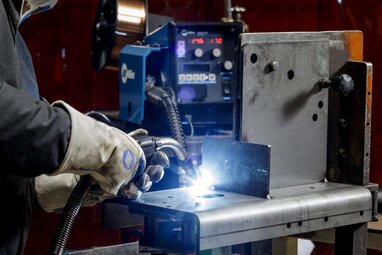Employee Training: Best Practices for Preparing New Welders
Estimated reading time: 4 minutes
Given the industry statistics regarding the number of experienced welders who are retiring from the field, many companies are likely training more new welders than ever before. By 2023, the nation’s workforce will need over 375,000 welders to satisfy the demands of several industries. [1]

Proper new welder training is essential to help companies meet quality and productivity goals. Consistent, thorough training also helps get welders onto the production floor as quickly as possible, allowing operations to meet throughput targets and customer timelines. Underscoring the importance of employee training, a study by the National Center on the Education Quality of the Workforce shows a 10% increase in workforce education can lead to an 8.6% increase in total productivity. [2]
There are various techniques and solutions for training new welders and resources available once training is complete.
3 primary learning styles
Welding is obviously a hands-on skill, but the best type of welder training for new employees may vary based on their learning style. Understanding the differences in learning styles can help companies tailor their training to best fit the way each individual learns. The three main learning styles are: [3]
Visual learning
People who have a visual learning style prefer to absorb new information by seeing the material being presented. They tend to remember things that are written down. Tips for reaching visual learners include turning notes into pictures, charts or maps; color coding parts of new concepts in any notes; focusing on learning the big picture first before drilling down to the details; and avoiding distractions.
Auditory learning
Learners who fall into this category prefer to learn through listening; they retain information best through hearing and speaking. Tips for reaching auditory learners include having them repeat the material out loud and in their own words; discussing the material in small groups; and having them read any new information or instructions out loud.
Kinesthetic learning
This type of learner prefers to learn by hands-on training. They would rather have a demonstration of how something works than a verbal explanation. Tips for this style of learner include taking frequent training breaks; have them learn new information while doing something active; and focus on hands-on demonstrations or lab work.
Covering the basics of welding training may differ for each type of learner. For example, a visual learner may want charts and graphics showing the different welding processes or parameters they will be using, while an auditory learner may want the trainer to explain those processes and parameters to them out loud. A kinesthetic learner may want to use a virtual reality or augmented reality welding training system to learn the skills in a hands-on manner.
Post-training tips
No matter what learning style is used in training, there are many solutions and welding technologies available that can help reinforce the information with welders once they are on the production floor.
Many of today’s welding power sources include technologies such as automatic presets and parameters windows that help ensure operators are using the best settings for the application. Weld data monitoring technology is another solution that can provide guidance to welders who have less experience. For example, some systems guide welders through the weld sequence in real time and will provide alerts if a weld is missed or outside of acceptable parameters.
Choosing welding equipment and consumables that are easy to install and use is another step companies can take to help welders of all experience levels produce high-quality welds. AccuLock™ welding consumables are designed to address common challenges in semi-automatic and robotic MIG welding applications. Simplified welding consumable replacement helps increase accuracy and reduce employee training requirements.
Resources for support
Many welding manufacturers also provide resources that companies can use to support welders after the training process. These resources include training manuals and welding guides found online, and how-to videos for welding equipment and consumables that are available on manufacturer websites or YouTube channels. QR codes on the welding equipment itself can be used to access how-to guides, training or machine updates.
These resources, coupled with the capabilities and ease-of-use engineered into today’s welding equipment and technologies, can help companies train new welders faster and support them once they are in production.
[1] American Welding Society: https://www.aws.org/foundation/page/workforce-development
[2] National Center on the Education Quality of the Workforce https://onlinemba.wsu.edu/blog/the-four-benefits-of-employee-training/
[3] Missouri State University: https://www.missouristate.edu/Assets/busadv/p-30.pdf